|
|
Ice
Spikes
... Strange things you can find in your freezer ... |
|
| What
are Ice Spikes? |
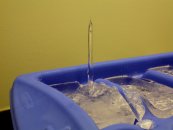 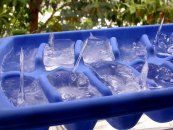 Ice spikes are odd ice structures that occasionally grow out of ice cube
trays. Unlike some of the strange things you might find growing in your
refrigerator, ice spikes are made of nothing but ice. Ice spikes are the result of
physics, not biology. Ice spikes are odd ice structures that occasionally grow out of ice cube
trays. Unlike some of the strange things you might find growing in your
refrigerator, ice spikes are made of nothing but ice. Ice spikes are the result of
physics, not biology.
Here are some pictures I took of ice spikes that grew in my kitchen freezer.
They look a lot like the limestone stalagmites found in caves, although there was
no water dripping inside my freezer when these formed.
To see your own ice spikes, make ice cubes in an ordinary ice cube tray, in
an ordinary household freezer, but using distilled water, which you can buy in
most supermarkets for about a dollar a gallon. We've tried several different
freezers, and almost always got some ice spikes to grow. |
| How do
Ice Spikes Form? |
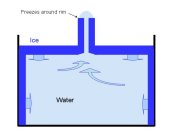 Ice spikes grow as the water in
an ice cube tray turns to ice. The water first freezes on the top surface, around
the edges of what will become the ice cube. The ice slowly freezes in from the
edges, until just a small hole is left unfrozen in the surface. At the same time,
while the surface is freezing, more ice starts to form around the sides of the cube. Ice spikes grow as the water in
an ice cube tray turns to ice. The water first freezes on the top surface, around
the edges of what will become the ice cube. The ice slowly freezes in from the
edges, until just a small hole is left unfrozen in the surface. At the same time,
while the surface is freezing, more ice starts to form around the sides of the cube.
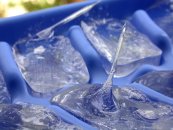 Since ice expands as it freezes, the ice freezing below the surface starts to push water
up through the hole in the surface ice (see diagram). If the conditions are just
right, then water will be forced out of the hole in the ice and it will freeze into an ice
spike, a bit like lava pouring out of a hole in the ground to makes a volcano. But
water does not flow down the sides of a thin spike, so in that way it is different from a
volcano. Rather, the water freezes around the rim of the tube, and thus adds to its
length. The spike can continue growing taller until all the water freezes, cutting
off the supply, or until the tube freezes shut. The tallest spike we've seen growing
in an ordinary ice cube tray was 56mm (2.2in) long.
Since ice expands as it freezes, the ice freezing below the surface starts to push water
up through the hole in the surface ice (see diagram). If the conditions are just
right, then water will be forced out of the hole in the ice and it will freeze into an ice
spike, a bit like lava pouring out of a hole in the ground to makes a volcano. But
water does not flow down the sides of a thin spike, so in that way it is different from a
volcano. Rather, the water freezes around the rim of the tube, and thus adds to its
length. The spike can continue growing taller until all the water freezes, cutting
off the supply, or until the tube freezes shut. The tallest spike we've seen growing
in an ordinary ice cube tray was 56mm (2.2in) long. |
| Why
Distilled Water? |
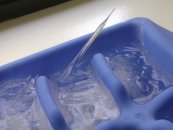 Most ice cube trays produce a few spikes, but usually only if
distilled water is used. Millions of people make ice cubes every day using ordinary
tap water, and most don't see ice spikes. Oddly enough, some people often get plenty
of ice spikes using ordinary tap water, but this appears to be rare. Most ice cube trays produce a few spikes, but usually only if
distilled water is used. Millions of people make ice cubes every day using ordinary
tap water, and most don't see ice spikes. Oddly enough, some people often get plenty
of ice spikes using ordinary tap water, but this appears to be rare.
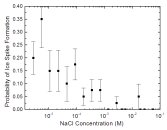
I have some ideas about why distilled water might make ice spikes more
readily than tap water, but so far I cannot explain why some tap waters make copious ice
spikes. We measured the probability of ice spike formation as a function of salt
(NaCl) concentration in distilled water, at a fixed temperature of -7C, which is shown in
the graph at right. Very little salt is needed to kill the ice spikes. All tap
waters contain relatively high concentrations of various mineral salts, so apparently
different impurities have different effects on ice spike formation. |
| What
Else Matters? |
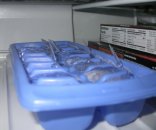 Temperature is certainly a factor
when growing ice spikes, and we have done experiments that show that spikes are more
likely to form when the temperature is just below freezing (see the graphs below).
I'm not entirely sure why this is so, but I suspect that the ice tube freezes shut before
the tube gets very long if the temperature is too low. So, if your ice cream is
really hard, your freezer is too cold to make lots of ice spikes. Temperature is certainly a factor
when growing ice spikes, and we have done experiments that show that spikes are more
likely to form when the temperature is just below freezing (see the graphs below).
I'm not entirely sure why this is so, but I suspect that the ice tube freezes shut before
the tube gets very long if the temperature is too low. So, if your ice cream is
really hard, your freezer is too cold to make lots of ice spikes.
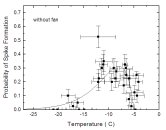 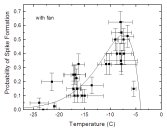 We've
also found that ice spikes form more readily if we install a fan that blows the air in the
freezer around. This is probably because the moving air provides some evaporative
cooling that makes the top of the ice spike freeze more readily, so the tube can develop
further before it freezes shut. At the optimum temperature, and with air blowing
over the freezing ice, about half the cubes in an ice cube tray will develop ice spikes. We've
also found that ice spikes form more readily if we install a fan that blows the air in the
freezer around. This is probably because the moving air provides some evaporative
cooling that makes the top of the ice spike freeze more readily, so the tube can develop
further before it freezes shut. At the optimum temperature, and with air blowing
over the freezing ice, about half the cubes in an ice cube tray will develop ice spikes.
|
You can read more about the scientific side of ice
spikes in our preprint (.pdf file).
|
 The graphs on this page were produced by
Kevin Lui (right), a undergraduate student at Caltech who spent a summer growing thousands
of ice cubes to investigate the physics behind ice spike formation. The graphs on this page were produced by
Kevin Lui (right), a undergraduate student at Caltech who spent a summer growing thousands
of ice cubes to investigate the physics behind ice spike formation.
I was first introduced to the ice spike phenomenon by John Cooper, although a
number of additional "sightings" have been posted at various times on the
web, such as here and here. Click here for
another informative ice spikes page from the University of Toronto.
|
|
